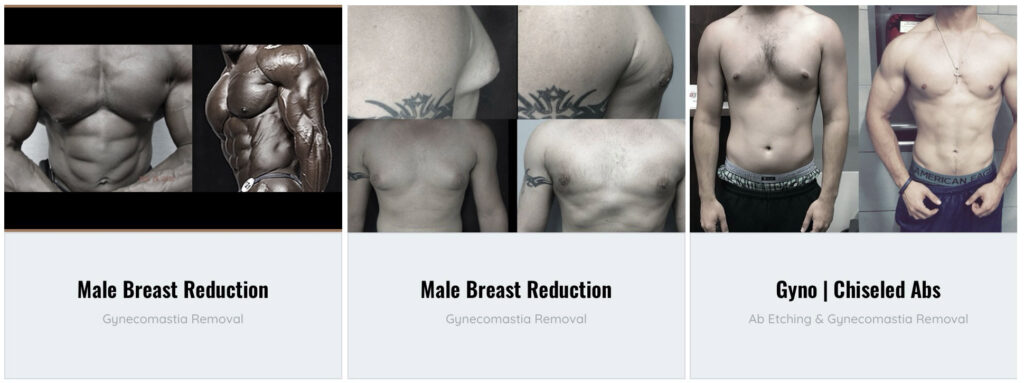
GYNECOMASTIA
What Is Gynecomastia?
Gynecomastia is an enlargement or swelling of breast tissue in males. It’s not normal, but it’s also not particularly uncommon. Between 50 and 60 percent of adolescent boys have the condition, as do up to 70 percent of men between the ages of 50 and 69. According to the American Society of Plastic Surgeons, nearly 27,000 surgeries to correct gynecomastia were performed in 2017.
We specialize in minimally invasive gynecomastia surgery which reduces breast size in men, flattening and enhancing the chest contour via gland excision sometimes combined with liposuction. We have preformed gynecomastia surgery on several bodybuilders (including some who went PRO) we’re well know in the body building community (see some testimonials on Professional Muscle website » ).
Gynecomastia Symptoms
In a male with gynecomastia, the breast tissue typically swells in a noticeable way. In some cases, the breasts may be tender and painful, and sometimes it causes a clear or opaque white discharge from one or both nipples. Psychological symptoms such as shame and embarrassment can develop as a result of the swelling.
Gynecomastia Causes
There are many potential causes of gynecomastia, including medications, substance abuse and hormonal conditions.
Medications that may cause gynecomastia include:
- Certain benzodiazepine anti-anxiety medications like Valium
- Certain cancer chemotherapy treatments
- Heart medications like calcium channel blockers and digoxin
- Highly active antiretroviral therapy, a treatment for HIV
- Medications to treat prostate conditions like enlarged prostate or prostate cancer
- Tricyclic antidepressants
- Ulcer medications
Abuse of the following substances has been known to cause gynecomastia in some cases:
- Alcohol
- Anabolic steroids
- Certain opioids
- Methamphetamines
- Marijuana
Additional factors—including medical conditions—include:
- Aging
- Hypogonadism disorders like Klinefelter’s syndrome or pituitary conditions
- Kidney failure
- Liver failure and cirrhosis of the liver
- Malnutrition
- Overactive thyroid
- Use of essential oils like tea tree and lavender
- Tumors of the testicles, adrenal glands or pituitary
Before & After Results:
Gynecomastia Treatment
Men with gynecomastia have a number of treatment options. Medication is sometimes an option. Some drugs used to treat breast cancer can also treat gynecomastia.
If the condition does not go away on its own and if medication proves ineffective, surgical removal of the breast tissue may be an option. Good candidates for surgery are men who:
- Are physically healthy, with no conditions that may impair post-surgical healing
- Have breasts that are no longer growing
- Have realistic expectations
- Have tried other treatments without success
The procedure for removing breast tissue is known as a mastectomy. It can be done through liposuction, excision or a combination of the two. Both liposuction and excision usually require the use of anesthesia.
However, at Advanced Surgeons we developed a minimally invasive technique which is done under local anesthesia, which results in less pain and quicker recovery. The procedure usually takes between 60 and 90 minutes, and patients are back to working out within two weeks.
See some of our before/after pics.
Liposuction is used when excess fat is causing the gynecomastia. During the procedure, a thin, hollow tube called a cannula is inserted through several incisions in the breasts. The cannula is moved back and forth to loosen the excess fat in the breast, then that fat is sucked out through the cannula.
An excision is done to remove dense tissue, also known as glandular tissue. This tissue differs from fatty tissue in that it is made of different cells. During excision, this tissue is cut out of the breast.
Recovery From Surgery
Gynecomastia surgery is usually an outpatient procedure, meaning the patient may leave the hospital or facility within 24 hours. Soreness is common in the first few days after the surgery. The incisions will have dressing or bandages over them and an elastic chest support is usually worn for a few days to reduce swelling. Scarring from the procedure will be minimal if the procedure is performed by a trained and skilled surgeon.




